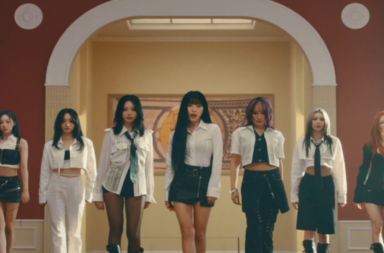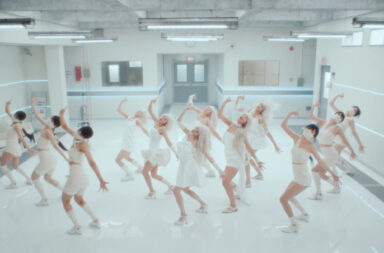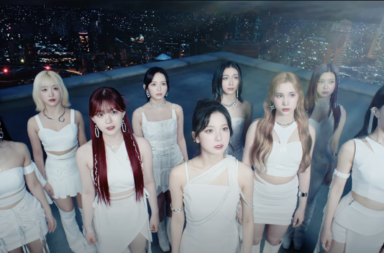
TXT (Tomorrow x Together) debuted in 2019 to high expectations, in no small part because they were the long-awaited juniors of BTS. They did not disappoint, showcasing their youthful charm and impressive dance skills in one catchy, chart-topping release after another. They are back to kick-off their second year in the industry with the EP The Dream Chapter: Eternity and its lead single “Can’t You See Me?”.
“Can’t You See Me?” follows in the footsteps of their previous title tracks by focusing on the topic of young friendship. “Crown” and “Run Away” both highlighted the joys of youthful bonds, and the way friendship can be a port in the storm of adolescent turbulence. “Can’t You See Me?” examines a different scenario, where friendship has become a source of the teenage anguish it once served to alleviate. By continuously contrasting innocent and ominous imagery in its MV, “Can’t You See Me?” paints a compelling portrait of the volatility of adolescent emotions, and how this can make even the most enduring of youthful friendships fragile.
The MV’s main plot revolves around the TXT members coming over to Soobin’s house to hangout. At first glance, as TXT share laughs while playing around, it appears to be a happy and normal gathering. Soon though, their smiles start to slip, and the visuals get progressively more ominous. Fire, scowls, and a predominance of red invade the previously heart-warming scene. What has gone wrong with TXT’s youthful friendship?
The opening lines of “Can’t You See Me?” explain the situation:
I’m yours, You were mine. Secrets of the world
That eternal promise was like magic
Our Scintilla bloomed underneath the starlight
Now see them burn in fire
Turned into ruins, our memories into ashes
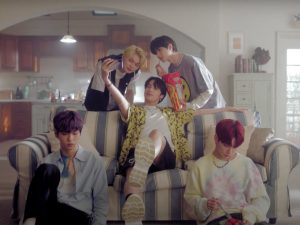
Once, TXT shared a profoundly close friendship. Together, they built a special bond meant to last forever, creating a “scintilla”–a synonym for spark. A spark is precious and full of possibility, but also fragile and easily extinguished. TXT’s friendship has proven to be the same.
What exactly tested TXT’s relationship is never explained, but it’s clear that it has negatively affected their bond. Their prior closeness only serves to exacerbate TXT’s feelings of betrayal and disappointment. They cry out the titular question “Can’t You See Me?” and bitterly repeat “Friends don’t understand me, understand me anymore” in each chorus, physically expressing their anguish through the song’s intense, almost violent choreography.

TXT’s strong emotional reaction to their friendship issues is understandable, but it also may be exacerbated by their youth. Neuroscience shows that teenagers are prone to dramatic mood swings. TXT express this youthful intensity and volatility of feeling in the MV, with visuals that abruptly switch from innocent to menacing. TXT cheerfully bake cookies, but the oven, filled with flames, frames them as they eat the fruits of their labor, creating a strangely ominous picture. A playful pillow fight between Beomgyu and Taehyun morphs in an instant into something that looks suspiciously like an attempt to murder through smothering. TXT’s feelings of despair are so strong, they can invade and corrupt even the most innocuous situation.
Among the most arresting recurring visuals in the MV are tomatoes and strawberries that are squished, squashed, and thrown everywhere in a boisterous food fight. The resulting visual is gruesome, as the red stains which cover the house and the members bear a striking resemblance to blood. However, these fruits are ultimately harmless weapons. This paradox points to the MV’s ambiguous stance on the seriousness and longevity of TXT’s friendship woes.
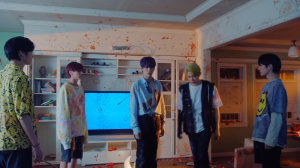
On one hand, the lyrics speak to a depth of emotional distress that feels significant, and this is backed up by the preponderance of disturbing imagery in the MV, and the overall dark tone of the song. Contrarily, some of the lyrics feel almost melodramatic in their intensity, like something you would shout in a fit of temper that would soon pass. Additionally, the dramatic nature of adolescent emotions, which is highlighted in the MV, could conceivably create a situation in which a small incident is blown out of proportion, resulting in an intense but temporary burst of negative feelings.
The continual coexistence of innocent and ominous imagery could serve as evidence for either perspective. In the second chorus, shots of TXT sitting blissfully together in the sun are intercut with darker imagery. This could mean that TXT are remembering better times in their moments of torment, or it could indicate that this turbulence is transitory and TXT will soon regain their happiness. That the MV never conclusively answers this query is to its benefit, allowing it to paint a comprehensive picture of the volatility and complexity of youthful emotions and consequently, youthful bonds.

Like their famous seniors at Big Hit Entertainment once did, TXT have been building a fictional universe, creating a collection of symbols and narratives that flow from one MV into the next. The opening of “Can’t You See Me?” situates the MV firmly in that universe by replaying a scene from “Run Away” in the flipping pages of a book.
Despite this, and the topical continuity shown by its examination of youthful friendship, some might argue that “Can’t You See Me?” is a significant departure for TXT. The group is generally known for their youthful, light-hearted exuberance, and “Can’t You See Me” is an undeniably moody and dark experience. In reality though, “Can’t You See Me?” simply leans into the dark undertones that have always been a part of TXT’s work.
“Crown” may musically be the definition of cheerful, but lyrically, it addresses subjects like isolation, fear of change, and self-loathing. These topics frequently recur in the rest of TXT’s discography. TXT’s previous MVs are not all sunshine and giggles either. “Nap of a Star”, one of the group’s most stunning MVs to date, has moments of true brutality tucked into its fantastical imagery. TXT interject moments of visual strangeness into all of their MVs, lending even their most sugary-sweet outings an intriguing edge. These tonal contrasts, which are on full display in “Can’t You See Me?”, make complete sense for a group whose predominant topic is the experience of youth. Adolescence is, after all, a time of equal parts intense joy and unbearable torment.
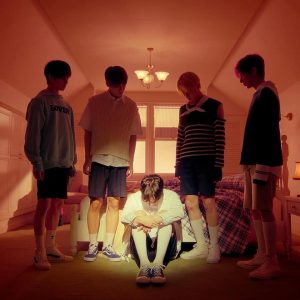
Unfortunately, “Can’t You See Me?” is also true to TXT’s tendency to take a “more is more” approach to their MVs, piling on visual imagery and symbolism with abandon. Sometimes this method surprisingly works, as with the evocative chaos of the “Run Away” MV. More frequently, it results in an intriguing but ultimately disappointing product, like the MV for “Cat & Dog”. “Can’t You See Me?” is mostly successful in its management of its many different visual pieces, but there are moments when so much is happening at once, it becomes overwhelming and the imagery starts to confuse, rather than aid the narrative.
“Can’t You See Me?” is an impressive chapter in TXT’s narrative of youth that feels both fresh and utterly true to the group’s established identity. In its short four-minute run, the MV memorably encapsulates the powerful, often volatile emotions that define youth, and make youthful friendships as fragile as they are precious. It will be exciting to see where TXT’s youthful journey takes them next.
(Psychology Today, Merriam-Webster, NPR, YouTube. Lyrics via YouTube. Images via Big Hit Entertainment)
